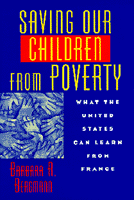

![]()
![]()

Bergmann motivates her comparative analysis with a simple, but powerful observation: the poverty rates for children in the United States and France are nearly identical before considering the effect of taxes and benefits, but dramatically different afterwards. Based on wage income alone, 23.3 percent of U.S. children are poor, slightly less than the 24.7 percent figure for France. (Bergmann defines a family as poor if the family's income is less than 50 percent of median family income.) However, after taxes and cash benefits are counted, while the U.S. poverty rate drops only slightly to 21.0 percent, the French rate plummets to 5.7 percent. The French system dramatically alters the extent to which children have access to necessary food, shelter, clothing and other material necessities.
Moreover, as Bergmann discusses at length, French poor children have access to high- quality early childhood education at Ecoles Maternelles. French poor children can attend these schools because all French children can, from the time they are toilet trained until first grade, at no cost to the parents. Attendance is nearly universal from ages 3 to 6, quality is generally high, and attendance reduces the probability that a student will repeat first grade. In comparison, the United States has a patch-work of disorganized programs, many linked to the receipt of public assistance. The U.S. spends money on custodial day care rather than nursery school, and subsidizes child care for welfare mothers while they are in 'Aid to Families with Dependent Children'- related (AFDC) training programs of questionable value rather than supporting actual work by mothers not on AFDC.
Bergmann details other differences between the French and American systems, providing a compact discussion of family allowances, child support assurance, and wage subsidies. While much of this material is familiar to persons with an interest in comparative social policy, the presentation here is a concise introduction to these topics, making the book a useful text for an introductory social policy course. The information on the French health care system, particularly that of prenatal care and aggressive home visitation for newborns, is less well known and illustrates a radically different approach to ensuring healthy outcomes for children. Like the policy of universal nursery schools, the inclusion of the poor in a universal medical program improves the quality of care the poor receive, reduces the stigma attached to government assistance, and maintains popular support for the system.
By Bergmann's estimate, the French accomplish all this by spending 59 percent more on a per-child basis. The costs are certainly not trivial - in France they amount to 5 percent of GDP compared to 3 percent on similar expenditures in the U.S. But while there is widespread dissatisfaction with both the costs and the outcomes of the American system, the French system is both more effective and more popular. However, Saving Our Children From Poverty illustrates that the question is not just one of money, but of inclusive institutional arrangements based on a national consensus about the importance of children. The French system is organized to support families and children, not merely praise them, and sharply reduces the effect of income inequality on children's lives.
As Bergmann notes, the United States currently lacks a political consensus that could support a move in the direction of the French system. Indeed, the Gingrich Congress with Bill Clinton's acquiescence has moved sharply in the opposite direction based on the perceived failures of the current system. If and when the pendulum swings back in the other direction, social policy analysts should be prepared to offer a substantially more coherent vision of child and family policy than the muddled and inadequate programs of the last 30 years. Saving Our Children from Poverty is an essential first step in that direction.
Paul A. Jargowsky, Visiting Associate Professor
John F. Kennedy School of Government
Harvard University